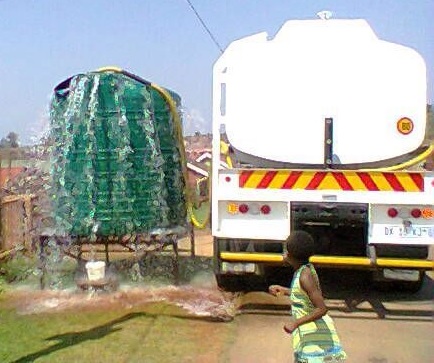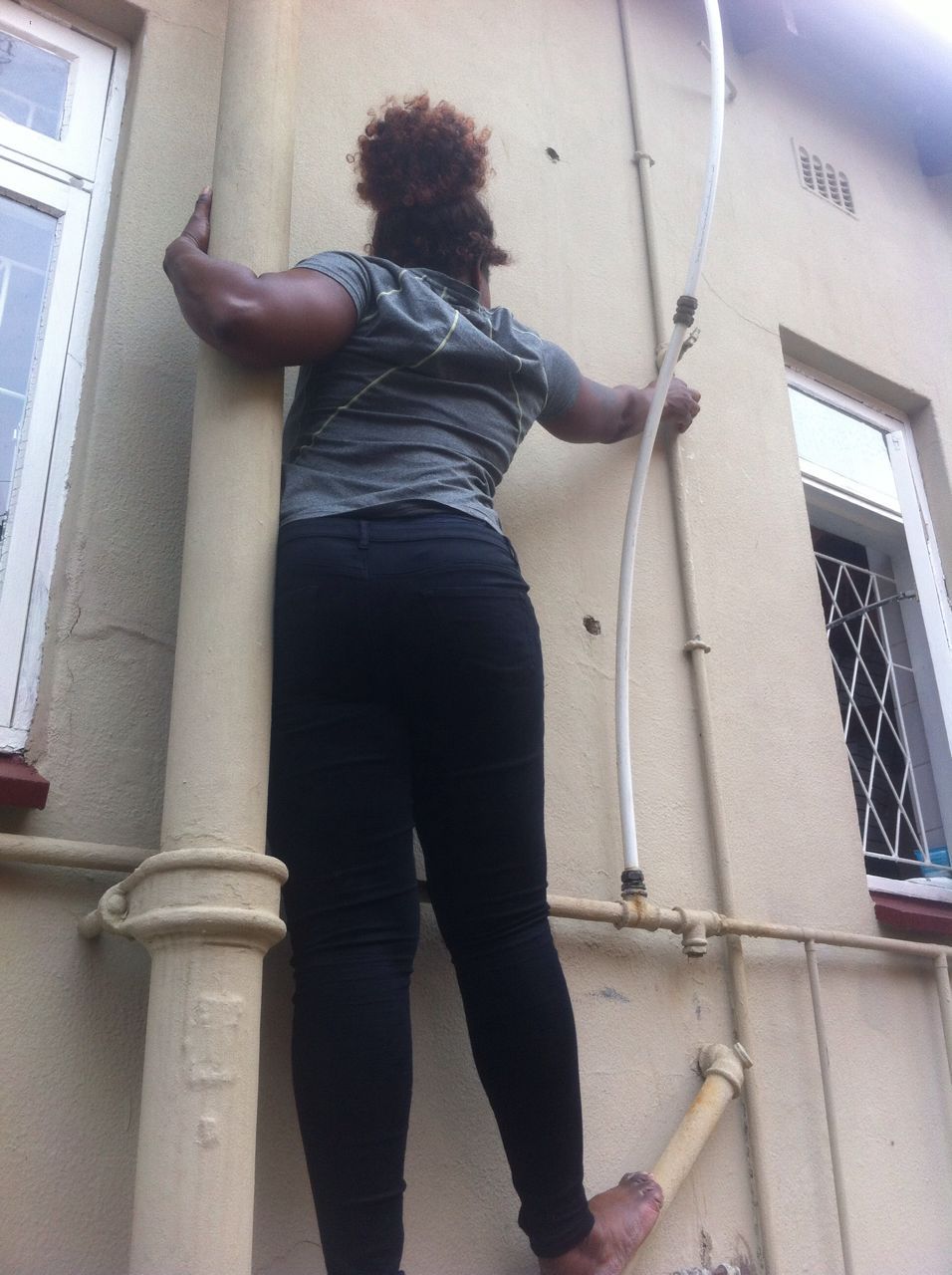 As I drove around Pietermaritzburg, I counted ten water restriction adverts. I imagined the state of the dwindling dam levels that, for my research, I follow day in, day out on the uMngeni Water website. I visited the site once more and checked Albert Falls, Inanda, Midmar, Spring Grove and Nagle Dams (the main water sources that supply Pietermaritzburg and Durban from the uMngeni River). Albert Falls, whose full storage capacity is 288.2 million cubic metres, is only 25.2% full, half of what it was around the same time last year. I looked skywards, trying to see nimbostratus or cumulonimbus clouds that are associated with rain. I also looked out for low flying swallows, as my grandmother had taught me when growing up herding cattle: “when you see swallows flying low, gather your flock and head home because in no time it will rain.” I quickly remembered that I was not in just any third world country, but in South Africa – a technologically advanced country, where information can be found with a single click. I checked the forecast on the Weather24 website – there were no signs of rains.
As I drove around Pietermaritzburg, I counted ten water restriction adverts. I imagined the state of the dwindling dam levels that, for my research, I follow day in, day out on the uMngeni Water website. I visited the site once more and checked Albert Falls, Inanda, Midmar, Spring Grove and Nagle Dams (the main water sources that supply Pietermaritzburg and Durban from the uMngeni River). Albert Falls, whose full storage capacity is 288.2 million cubic metres, is only 25.2% full, half of what it was around the same time last year. I looked skywards, trying to see nimbostratus or cumulonimbus clouds that are associated with rain. I also looked out for low flying swallows, as my grandmother had taught me when growing up herding cattle: “when you see swallows flying low, gather your flock and head home because in no time it will rain.” I quickly remembered that I was not in just any third world country, but in South Africa – a technologically advanced country, where information can be found with a single click. I checked the forecast on the Weather24 website – there were no signs of rains.
That evening, I checked into a lodge in Scottsville and I was quite impressed with the set up until I went to take a shower. The first thing I noted was that there was a leak in one of the shower pipes. I reported this to one of the staff members who casually replied, “It’s just a small drip.” I contemplated showing her a headline in one of the local newspapers that read: “The KZN area loses close to 50 percent of its purified water through pipe leaks, theft, neglect and wasteful use.’’ Fearing a negative response, I decided against it.
 The following day I embarked on my research journey. I drove around to familiarise myself with the area. I noticed two contrasting sights that boggled my mind – water restriction posters around the town, and puddles caused by water leaks. Along Grimthorpe Road, I took a picture of a leaking pipe at a gated complex. The water must have been running for some time judging by the algae that had accumulated in the rivulet that had formed. In Mpumuza, a location just out of Pietermaritzburg town I spotted a water tank driver filling a JoJo tank for the community, but it was overflowing for some time after the driver had wandered off. I discovered that in some areas the taps on JoJo tanks were deliberately vandalised by residents who felt the tap was not releasing water fast enough. I began to think there was a culture of water negligence.
The following day I embarked on my research journey. I drove around to familiarise myself with the area. I noticed two contrasting sights that boggled my mind – water restriction posters around the town, and puddles caused by water leaks. Along Grimthorpe Road, I took a picture of a leaking pipe at a gated complex. The water must have been running for some time judging by the algae that had accumulated in the rivulet that had formed. In Mpumuza, a location just out of Pietermaritzburg town I spotted a water tank driver filling a JoJo tank for the community, but it was overflowing for some time after the driver had wandered off. I discovered that in some areas the taps on JoJo tanks were deliberately vandalised by residents who felt the tap was not releasing water fast enough. I began to think there was a culture of water negligence.
When I got back to the lodge that evening the ‘small drip’ in the shower was now gushing but still no-one seemed to care. I realised that the gush would probably worsen as water pressure was normally low in the morning and increased in the evening.
 Water pressure in the Pietermaritzburg mains network is not always constant – it changes in response to the peak demand periods in the city. Pressure reduction is used as a method of saving water. However, fluctuations in water pressure can lead to high leakage rates, particularly in areas with aging pipes. I went back again to one of the staff members and reported the leak, but she casually replied that it was rather late to call in a plumber – the only one nearby finished work at 5pm. I thought of the water gushing throughout the night and at the same time thought of the dwindling water in the dams, and the lack of signs of rain. I knew I couldn’t ignore it, so I went back to the staff member and asked her to show me where the pipe was running from so I could try to find a solution for the night. She didn’t seem to have an idea of what I was talking about, but I went outside, located the inlet pipe, climbed the wall and closed the inlet tap. As I climbed down the wall I felt like shouting: ‘Wake up and smell the coffee Pietermaritzburg! You are facing a meteorological drought!’
Water pressure in the Pietermaritzburg mains network is not always constant – it changes in response to the peak demand periods in the city. Pressure reduction is used as a method of saving water. However, fluctuations in water pressure can lead to high leakage rates, particularly in areas with aging pipes. I went back again to one of the staff members and reported the leak, but she casually replied that it was rather late to call in a plumber – the only one nearby finished work at 5pm. I thought of the water gushing throughout the night and at the same time thought of the dwindling water in the dams, and the lack of signs of rain. I knew I couldn’t ignore it, so I went back to the staff member and asked her to show me where the pipe was running from so I could try to find a solution for the night. She didn’t seem to have an idea of what I was talking about, but I went outside, located the inlet pipe, climbed the wall and closed the inlet tap. As I climbed down the wall I felt like shouting: ‘Wake up and smell the coffee Pietermaritzburg! You are facing a meteorological drought!’
I decided to keep quiet, and as I sat down to ponder on my day’s experiences, I recalled something that I had read in an article about Pietermaritzburg by Duncan Hay: “Self-regulate: Government cannot regulate everything and it shouldn’t. Just as many business sectors and industrial activities regulate themselves and each other through norms, standards and codes of conduct, so should we as water users be regulating our own behaviour.”
I considered the efforts the South African government was putting in to deal with water shortages in KwaZulu Natal. The water restrictions, reduction of water pressure, construction of more dams, inter basin transfers, grey water reticulation, the initiation of the Drop-the-Block campaign and many more. (Drop-the-Block is based on the principle of displacing just enough water to still enable the flushing of the toilet. Currently cisterns hold 9-15 litres of clean drinking water which is dispensed with each flush. The block reduces the use of water from 9 to 7 litres). The culture of negligence again ran through my mind, and I knew I would soon find out why this was so prevalent.
As I carried out my field work I chatted to people about the drought and water situation in their area. I soon learnt that their negligence was rooted in their ignorance of the situation. There was a capacity deficiency among ordinary citizens. They were not aware of the difference they could make by being water-wise. They saw investment in water infrastructure as the only panacea to deal with water shortages, and when I asked about the leaks in their taps, they replied: “it’s only a small drip.” It became apparent that investments in water infrastructure need to be complemented by a much greater investment in knowledge and capacity development. This has been reiterated in many water forums – for example, the Asia-Pacific Water Forum in 2006 recommended that for every (US) dollar invested in infrastructure, another seventy cents should be invested on the soft side, including education and capacity building (UNESCO-IHE & UNW-DPC, 2009).
Fundamentally, capacity building relies on two interrelated concepts. First, the strengthening of institutions at all levels to deal more efficiently and effectively with sustainable water resources development including the creation of a favourable policy environment, water resources assessment (both quantity and quality), planning, management, programme and project formulation, implementation and evaluation. In this regard South Africa has done exceptionally well. Its 1998 National Water Act calls for stakeholder participation. Secondly, the development of the human resources needed at all levels, including education and training.
From my experience in Pietermaritzburg I noted that the problems lay in poorly capacitated communities. Poor capacitation can weaken the ability to manage resources. Communities need to be capacitated in:
- Basic plumbing skills. (The Duzi Umgeni Conservation Trust (DUCT) has launched an Enviro-champs programme in the Mpopomeni community in the upper uMngeni River which offers basic plumbing skills to voluntary community members).
- Basic skills on water saving.
- Fixing leaking pipes.
- Adjusting pressure-reducing valves.
These are some of the skills that could assist in addressing deficient capacity and overcome the culture of water negligence in the future. They are also key components of effective water stewardship, and can be complemented with greater awareness programmes on the threats facing Pietermaritzburg.
Hlengiwe Dube is studying for an MSc in Integrated Water Management at Monash South Africa, funded by an IWSN scholarship.
